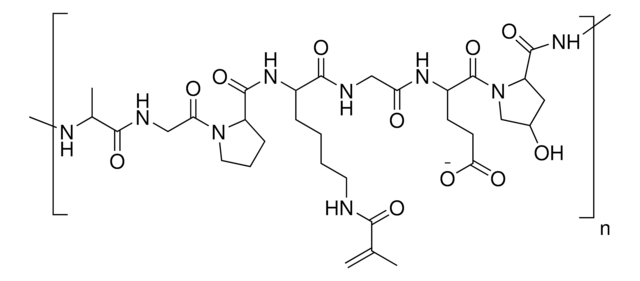925217
TissueFab® - low endotoxin GelMA-UV bioink
0.2 μm filtered, suitable for 3D bioprinting applications
Synonym(s):
Bioink, GelMA, Gelatin methacrylamide, Gelatin methacrylate, Gelatin methacryloyl
About This Item
Recommended Products
Quality Level
sterility
0.2 μm filtered
form
viscous liquid (to gel)
size
10 mL
impurities
≤5 CFU/g Bioburden
≤5 CFU/g Bioburden (Aerobic)
≤50 EU/mL Endotoxin
color
pale yellow to colorless
pH
6.5-7.5
viscosity
2-20 cP
application(s)
3D bioprinting
storage temp.
2-8°C
Related Categories
General description
The addition of photocrosslinkable methacrylamide functional groups in GelMA allows the synthesis of biocompatible, biodegradable, and non-immunogenic hydrogels that are stable in biologically relevant conditions and promote cell adhesion, spreading, and proliferation.
Temporal and spatial control of the crosslinking reaction can be obtained by adjusting the degree of functionalization and polymerization conditions, allowing for the fabrication of hydrogels with unique patterns, 3D structures, and morphologies.
Application
- osteogenic,
- chondrogenic ,
- hepatic ,
- adipogenic ,
- vasculogenic ,
- epithelial ,
- endothelial ,
- cardiac valve ,
- skin ,
- tumors
Features and Benefits
- Ready-to-use formulation optimized for high printing fidelity and cell viability, eliminating the lengthy bioink formulation development process
- Step-by-step protocols developed and tested by MilliporeSigma 3D Bioprinting Scientists, no prior 3D bioprinting experience neede
- Suitable for different extrusion-based 3D bioprinter model
- Methacrylamide functional group can also be used to control the hydrogel physical parameters such as pore size, degradation rate, and swell ratio.
Legal Information
Storage Class Code
10 - Combustible liquids
WGK
WGK 3
Certificates of Analysis (COA)
Search for Certificates of Analysis (COA) by entering the products Lot/Batch Number. Lot and Batch Numbers can be found on a product’s label following the words ‘Lot’ or ‘Batch’.
Already Own This Product?
Find documentation for the products that you have recently purchased in the Document Library.
Articles
Learn how 3D bioprinting is revolutionizing drug discovery with highly-controllable cell co-culture, printable biomaterials, and its potential to simulate tissues and organs. This review paper also compares 3D bioprinting to other advanced biomimetic techniques such as organoids and organ chips.
Learn how 3D bioprinting is revolutionizing drug discovery with highly-controllable cell co-culture, printable biomaterials, and its potential to simulate tissues and organs. This review paper also compares 3D bioprinting to other advanced biomimetic techniques such as organoids and organ chips.
Learn how 3D bioprinting is revolutionizing drug discovery with highly-controllable cell co-culture, printable biomaterials, and its potential to simulate tissues and organs. This review paper also compares 3D bioprinting to other advanced biomimetic techniques such as organoids and organ chips.
Learn how 3D bioprinting is revolutionizing drug discovery with highly-controllable cell co-culture, printable biomaterials, and its potential to simulate tissues and organs. This review paper also compares 3D bioprinting to other advanced biomimetic techniques such as organoids and organ chips.
Our team of scientists has experience in all areas of research including Life Science, Material Science, Chemical Synthesis, Chromatography, Analytical and many others.
Contact Technical Service




